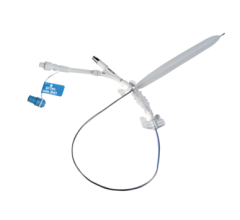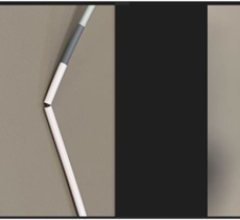
September 24, 2018 — New data announced at the 2018 Transcatheter Cardiovascular Therapeutics (TCT) conference, Sept. 21-25 in San Diego, reinforce the safety, durability and consistency of the In.Pact Admiral drug-coated balloon (DCB) in real-world patients with peripheral arterial disease (PAD). Three-year real-world results from the full clinical cohort of the IN.PACT Global Study and one-year data from the Total IN.PACT pooled imaging and propensity analyses were presented at the TCT conference and the Cardiovascular and Interventional Radiological Society of Europe (CIRSE) annual meeting, Sept. 22-26 in Lisbon, Portugal, respectively.
Prof. Gunnar Tepe, M.D., director of diagnostic and interventional radiology at the Academic Hospital RoMed Clinic in Rosenheim, Germany, presented the new, three-year results from the full clinical cohort of the IN.PACT Global Study. The results are the first three-year, real-world, fully adjudicated DCB data to be presented in a scientific congress and showed durability of treatment effect in a real-world population.
The freedom from clinically-driven target lesion revascularization (CD-TLR) rate calculated using Kaplan Meier survival estimates was 76.9 percent in a real-world patient cohort with a mean lesion length of 12.09 ± 9.54 cm, 18 percent in-stent restenosis, 35.5 percent occluded lesions and 39.9 percent diabetic subjects. Additionally, the proportion of patients undergoing repeat procedures were low through three years: major target limb amputations, 0.8 percent and CD-TLR, 23.5 percent (n=1,406).
“Superficial femoral artery (SFA) disease is becoming more prevalent globally and is often difficult to treat due to its complex nature. Now more than ever, it is important to carefully assess how therapies to treat this condition perform over the long-term among real-world patients,” said Tepe. “IN.PACT Global was designed with this goal in mind and has now demonstrated the durability, efficacy, and safety of In.Pact Admiral in complex lesions out to three years — something few SFA studies have been able to achieve thus far.”
The IN.PACT Global Study is the largest and most rigorous real-world evaluation of any peripheral artery intervention ever undertaken, according to Medtronic. It intends to characterize the performance of the In.Pact Admiral DCB in treating real-world patients with challenging and complex lesions. The study included adjudication of events by an independent clinical events committee.
Mehdi Shishehbor, D.O., M.P.H., Ph.D., director of the Heart and Vascular Institute, University Hospitals Cleveland Medical Center, presented one-year overall imaging and propensity-matched imaging data from the Total IN.PACT Pooled Analysis at TCT. The Total IN.PACT Pooled Analysis is an undertaking by Medtronic to enhance the understanding of PAD patient treatment algorithms by characterizing the clinical performance of In.Pact Admiral in the largest and most diverse study population treated with DCBs to date.
Total IN.PACT combined independently adjudicated data from a total of 1,837 patients treated with In.Pact Admiral DCB from all In.Pact Admiral randomized clinical trials and real-world studies from 147 sites across 28 countries. The analyses presented at TCT specifically looked at two different groups – a core laboratory-adjudicated imaging cohort and a propensity matched imaging cohort. The data showed that In.Pact Admiral DCB demonstrated consistently superior patency and freedom from clinically-driven target lesion revascularization (CD-TLR) compared to standard percutaneous transluminal angioplasty (PTA) alone.
The imaging cohort, which evaluated 926 DCB and 143 PTA subjects, demonstrated a patency rate of 88.8 percent for In.Pact Admiral compared to 53.9 percent for PTA (p<0.001) and a freedom from clinically-driven target lesion revascularization (CD-TLR) rate of 94.3 percent compared to 80.2 percent for PTA (p<0.001). Additional safety and effectiveness outcomes from the DCB arm also included low rates of thrombosis (2.4 percent), and CD-TLR (5.8 percent), and no occurrences of major target limb amputation at one year.
The propensity analysis (a subset of the imaging cohort) matched one PTA subject with up to four In.Pact Admiral DCB subjects based on baseline variables (136 PTA subjects and 466 DCB subjects). The propensity-matched analysis showed a patency rate of 90.5 percent for the In.Pact Admiral DCB as compared to 53.8 percent for PTA (p<0.001), and a freedom from CD-TLR rate of 96.9 percent compared to 80.7 percent for PTA (p<0.001). Additional safety and effectiveness outcomes from the DCB arm also included low rates of thrombosis (1.6 percent) and CD-TLR (3.3 percent), and no occurrences of major target limb amputation at one year.
“By pooling data from multiple IN.PACT study cohorts, we are able to glean valuable insights into clinical outcomes across a broad spectrum of patient and lesion types beyond the reach of typical cohort DCB analyses,” said Shishehbor. “Despite having more advanced lesions, the Total IN.PACT data presented today at TCT further confirm the consistent performance we’ve seen across IN.PACT studies by showing approximately 35 percent superior patency with DCB compared to PTA in the imaging cohort and approximately 37 percent superior patency with DCB compared to PTA in the propensity-matched cohort at one year. This calls into question the use of primary PTA therapy in an era of drug-eluting technologies like In.Pact Admiral.”
For more information: www.medtronic.com


 June 13, 2024
June 13, 2024 








